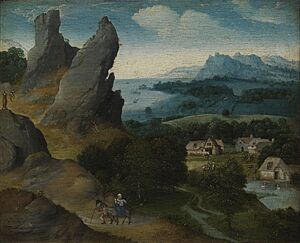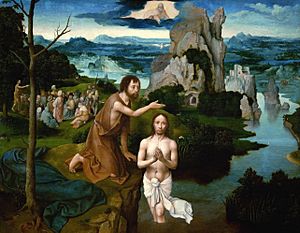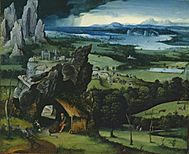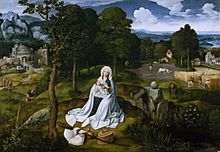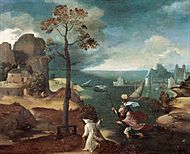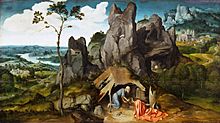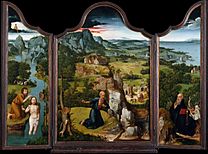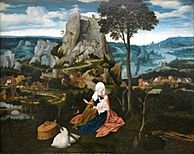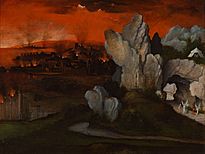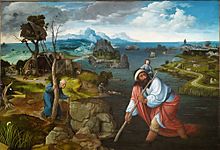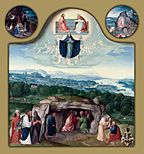Joachim Patinir facts for kids
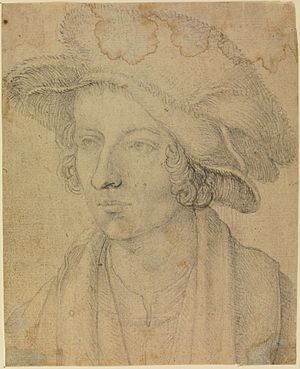
Joachim Patinir (around 1480 – 5 October 1524) was a famous Flemish Renaissance painter. He was known for his amazing landscape paintings. He also painted history scenes.
Patinir was from a region called Wallonia in modern-day Belgium. But he worked in Antwerp, which was a big art center in the Low Countries back then. He was one of the first artists to focus mainly on landscapes. He even called himself a landscape painter!
He created a special style called the "world landscape". These paintings showed huge, wide views of nature. This style was a very important gift from Patinir to Western art. His work helped change how artists painted perspective in landscapes.
Patinir was friends with other famous artists. These included Albrecht Dürer and Quentin Metsys. He often worked with Metsys. For example, in The Temptation of St Anthony, Patinir painted the landscape, and Metsys added the people.
Life of a Landscape Artist
Joachim Patinir was born in Dinant or Bouvignes, in what is now Belgium. In 1515, he joined the Antwerp's Guild of Saint Luke. This was a special group for artists. He lived and worked in Antwerp for the rest of his life.
Some people think he might have studied art in Bruges. He might have learned from Gerard David. David also joined the Antwerp Guild in the same year as Patinir. It's also thought that Patinir traveled to Genoa in 1511. He might have gone with David and another artist, Adrien Ysenbrandt.
Patinir was married twice. His first wife was Francisca Buyst. After she passed away, he married Johanna Noyts on May 5, 1521. His friend Albrecht Dürer even came to his second wedding! Dürer drew a picture of Patinir. Dürer called him "der gute Landschaftsmaler", which means "the good landscape painter". This helped create a new way to describe artists who painted landscapes.
Patinir had three daughters. Two were from his first marriage and one from his second. He had a big art workshop in Antwerp. He had many helpers. However, he didn't officially register any students with the Antwerp guild.
Joachim Patinir passed away in Antwerp in 1524. After his death, his friend Quentin Metsys became the guardian of his daughters.
Patinir's Unique Paintings
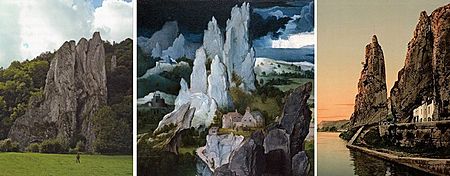
We only know of five paintings that Patinir signed himself. But many other artworks are believed to be by him or his workshop. When he did sign his work, it said: (Opus) Joachim D. Patinier. The "D" meant Dionantensis, showing he was from Dinant.
In Patinir's paintings, the landscapes are often huge. The people in them look very small. Sometimes, other artists would paint the figures for him. This was a common way for artists to work together back then. Many of his paintings were also quite large for the time.
Patinir's big, wide views mix real details from nature with a touch of fantasy. The tall, sharp rocks you see in his landscapes are like the amazing rock formations near his hometown of Dinant. These unique rocks became a key part of his "world landscape" style. Other painters copied this style, even if they had never seen the real rocks.
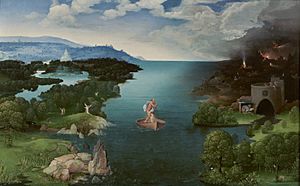
His landscapes often show a high viewpoint. It's like looking down from a mountain. The horizon line is also very high. He used a special color plan that influenced many later landscape painters. The front part of his paintings is usually brownish. The middle part is a bluish-green. And the background is a pale blue. This makes the painting look like it goes far into the distance. Sometimes, these colors, along with dark clouds and sharp rocks, can make the scene feel a bit mysterious or even a little scary.
Selected Works
-
Landscape with Saint Christopher, around 1520.
See also
 In Spanish: Joachim Patinir para niños
In Spanish: Joachim Patinir para niños
- Early Renaissance painting
- Renaissance in the Low Countries


